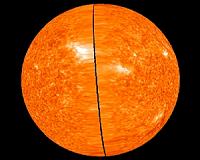 |
Washington DC (SPX) Feb 08, 2011 For the first time in history a stunning view of the whole Sun is visible to the world. The unique 360 degrees view of the Sun was unveiled on Sunday 6 February 2011 after NASA's two STEREO (Solar TErrestrial RElations Observatory (link opens in a new window)) spacecraft were aligned exactly opposite each other on either side of the Sun. The 360 degrees coverage from STEREO is enhanced by NASA's SDO (Solar Dynamics Observatory (link opens in a new window)) mission which images the Sun in high resolution. As the STEREO probes continue flying to the far side of the Sun, the area of unseen solar territory on the near side will increase, and SDO's cameras will play a vital role in filling the gap. Working together, these new views of the Sun will allow scientists to better predict space weather and the violent eruptions from the Sun's surface. These can damage satellites, disrupt communications and disable power systems on Earth. The UK, including STFC scientists and engineers, has provided essential expertise and technology to both SDO and STEREO. The instruments for both missions use cameras designed and built at STFC's Rutherford Appleton Laboratory (RAL). Minister for Universities and Science David Willetts said, "Our Universe is truly fascinating, yet so much of it is still a mystery. This breakthrough has the potential to teach us so much more about what lies beyond our planet, and I'm extremely proud that UK scientists have played a pivotal role in the research and development of this important imaging technology." Professor Richard Harrison, Principal Investigator for the UK instruments on STEREO and SDO Co-Investigator said, "The Sun is a truly complex object which influences many aspects of our lives. In the same way that you would not expect to understand the workings of the brain by studying just a small part of it, a global investigation into the nature of our star as a complete object is essential to understanding how it works." Dr Chris Davis, STFC STEREO Project Scientist said, "The STEREO mission has already shown us some wonderful sights, solar eruptions arriving at the Earth to comets struggling against the solar wind. I'm very excited about this new stage of the mission and am looking forward to many years of unique observations." Dr Davis is also a leading scientist in Solar Stormwatch (link opens in a new window), a project in which members of the public use images from STEREO to spot explosions on the Sun, track them across space to Earth and provide an early warning to astronauts. Dr David Parker, Director of Space Science and Exploration for the UK Space Agency (link opens in a new window), said, "Solar missions such as STEREO and SDO not only give us more information about star formation and evolution throughout our Universe but are of vital importance in our quest to further understand the Sun's processes and the effect they can have on our planet and way of life. This spectacular 360 degrees view is another triumph for the STEREO mission which continues to obtain some of the best images yet of the Sun. We're extremely proud of our skilled UK team who are playing an important role in this mission and helping to further unravel the secrets of our star." Scientists have already established that the magnetic fields in the Sun's atmosphere drive solar activity on a global scale. This view of the entire Sun will enable more detailed studies of these processes at work. The 360 degrees observations will continue for the lifetime of the missions.
Share This Article With Planet Earth
Related Links NASA STEREO website Solar Science News at SpaceDaily
 First Ever STEREO Images Of Entire Sun
First Ever STEREO Images Of Entire SunHuntsville AL (SPX) Feb 07, 2011 It's official: The sun is a sphere. On Feb. 6th, NASA's twin STEREO probes moved into position on opposite sides of the sun, and they are now beaming back uninterrupted images of the entire star-front and back. "For the first time ever, we can watch solar activity in its full 3-dimensional glory," says Angelos Vourlidas, a member of the STEREO science team at the Naval Research Lab in Wash ... read more |
|
| The content herein, unless otherwise known to be public domain, are Copyright 1995-2010 - SpaceDaily. AFP and UPI Wire Stories are copyright Agence France-Presse and United Press International. ESA Portal Reports are copyright European Space Agency. All NASA sourced material is public domain. Additional copyrights may apply in whole or part to other bona fide parties. Advertising does not imply endorsement,agreement or approval of any opinions, statements or information provided by SpaceDaily on any Web page published or hosted by SpaceDaily. Privacy Statement |